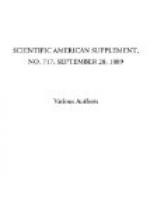Though this is a subject which is altogether beyond me, I have been able to use the results in a practical way. When it is required to place into an instrument a fiber of any particular size, all that has to be done is to hold the frame of fibers toward a bright and distant light, and look at them through a low-angled prism. The banded spectra are then visible, and it is the work of a moment to pick out one with the number of bands that has been found to be given by a fiber of the desired size. A coarse fiber may have a dozen or more, while such fibers as I find most useful have only two dark bands. Much finer ones exist, showing the colors of the first order with one dark band; and fibers so fine as to correspond to the white or even the gray of Newton’s scale are easily produced.
Passing now from the most scientific test of the uniformity of these fibers, I shall next refer to one more homely. It is simply this: The common garden spider, except when very young, cannot climb up one of the same size as the web on which she displays such activity. She is perfectly helpless, and slips down with a run. After vainly trying to make any headway, she finally puts her hands (or feet) into her mouth and then tries again, with no better success. I may mention that a male of the same species is able to run up one of these with the greatest ease, a feat which may perhaps save the lives of a few of these unprotected creatures when quartz fibers are more common.
It is possible to make any quantity of very fine quartz fiber without a bow and arrow at all, by simply drawing out a rod of quartz over and over again in a strong oxyhydrogen jet. Then, if a stand of any sort has been placed a few feet in front of the jet, it will be found covered with a maze of thread, of which the photograph on the screen represents a sample. This is hardly distinguishable from the web spun by this magnificent spider in corners of greenhouses and such places. By regulating the jet and the manipulation, anything from one of these stranded cables to a single ultro-microscope line may be developed.
And now that I have explained that these fibers have such valuable properties, it will no doubt be expected that I should perform some feat with their aid which, up to the present time, has been considered impossible, and this I intend to do.
Of all experiments, the one which has most excited my admiration is the famous experiment of Cavendish, of which I have a full size model before you. The object of this experiment is to weigh the earth by comparing directly the force with which it attracts things with that due to large masses of lead. As is shown by the model, any attraction which these large balls exert on the small ones will tend to deflect this 6 ft. beam in one direction, and then if the balls are reversed in position, the deflection will be in the other direction. Now, when it is considered how enormously greater the earth is than these balls,




